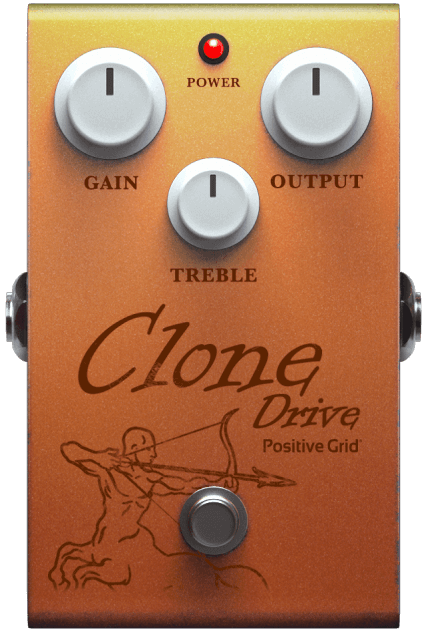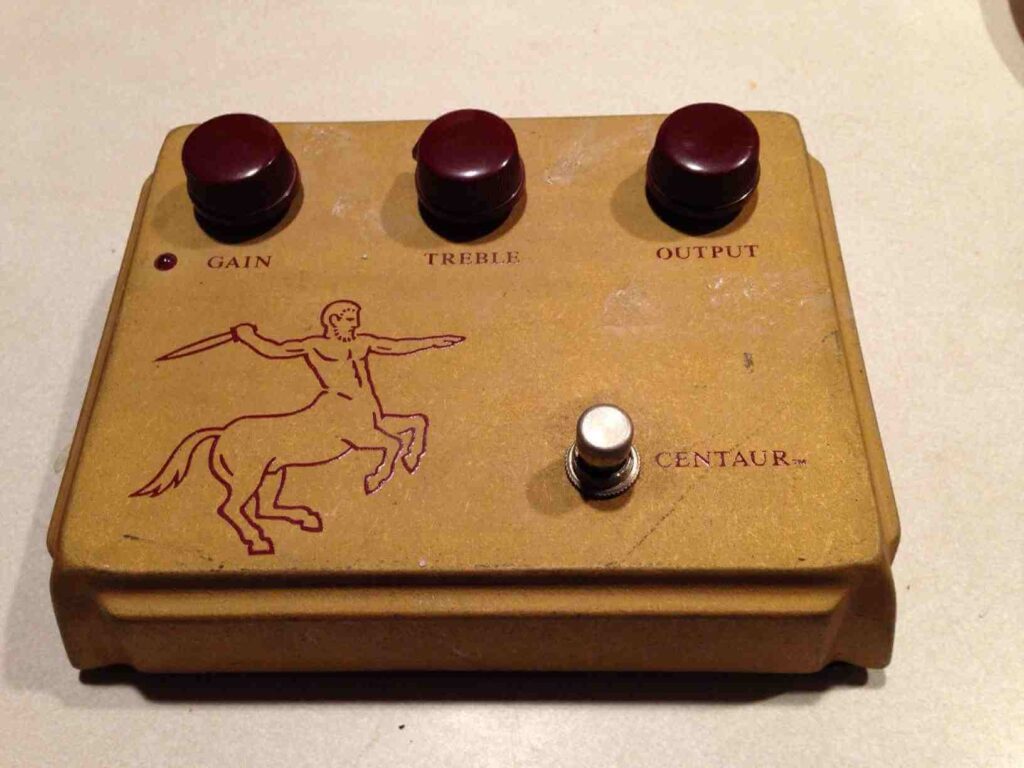Note: This article has been updated with lastest available information on January 13th, 2022 at 08:29 pm
Positive Grid Clone Drive pedal is available under the Drive effect group and is inspired by the mythic Klon Centaur pedal.



The Klon Centaur is an overdrive pedal made by the American engineer Bill Finnegan between 1994 and 2008. Finnegan aimed to create a pedal that would recreate the harmonically rich distortion of a guitar amplifier at a high volume.
Finnegan struggled to meet demand, and used units sold for inflated prices. He made around 8,000 units before discontinuing the Klon in 2008. In 2014, Finnegan redesigned it as the Klon KTR, which is simpler to manufacture by contracted firms. Numerous manufacturers have created Klon clones. As of 2024, used Klon Centaurs sold for up to $20,000 USD.
Development
In the 1990s, the American engineer Bill Finnegan sought an overdrive pedal that would recreate the harmonically rich distortion of a guitar amplifier at a high volume.[1] He wanted a "big, open" sound, with a "hint of tube clipping", that would not sound like a pedal was being used.[1] He experimented with the Ibanez Tube Screamer, but was not satisfied.[1]
With electrical engineer friends, including the MIT graduate Fred Fenning, Finnegan developed prototype pedals in his spare time over four and a half years.[1] He added an internal voltage converter to double the voltage, which creates headroom and produces "higher-order harmonic content".[2]
After extensive experimentation, Finnegan selected low-gain germanium diodes for the circuit and purchased as many as he could afford.[1][2] The diodes use hard rather than soft clipping, to "provide a more subtle saturation and a very transparent response".[2] When the user increases the gain control, the bass frequencies are reduced, preventing the pedal from sounding "woofy" or "muddy".[2] Finnegan coated the components in epoxy resin to make the pedal harder to replicate.[1][3]
Finnegan designed the Klon Centaur to be used in conjunction with an amplifier's natural overdrive to add sustain and volume, as opposed to using it as a source of distortion with a clean amplifier.[2]
Sales
Finnegan first sold the Klon Centaur in late 1994.[1] He was overwhelmed by demand and worked long hours in his home, building, testing and shipping the pedals himself. Every part was custom made, including the cast enclosure, knobs and pots.[1] In total, Finnegan built around 8,000 pedals over 15 years.[1]
As it took Finnegan 12 to 14 weeks to fulfil each order, used Centaur pedals sold for inflated prices. This placed more pressure on Finnegan to meet demand.[1] Finnegan said his profit margin was "not very sensible", and he found it difficult to hire employees and expand the business in Boston, where commercial space was expensive.[1]
In 2008, Finnegan decided the situation was unsustainable and discontinued the Centaur.[1] He declined large requests to make more, but continued to make them for a close friend, a single mother who needed financial support, to sell on eBay.[1]
Legacy
The Klon Centaur has been used by guitarists including Jeff Beck, John Mayer, Joe Perry (of Aerosmith), Nels Cline (of Wilco), Matt Schofield and Ed O'Brien (of Radiohead).[1][4] Finnegan said the pedal attracted a variety of guitarists, including baby boomers, younger indie rock musicians and experimental musicians.[1] Guitar World praised the clear, uncolored tone of the boosted signal.[5]
As of 2019, used Centaurs sold for between $1,900 and $2,500 USD.[6] As of 2024, they sold for up to $20,000 USD.[2] According to Guitar.com, which named the Centaur one of the greatest effect pedals, "The Klon Centaur is either the greatest, most useful overdrive ever made, or the worst example of guitarists losing all sense of perspective about how much good tone should cost."[6]
In early 2023, Josh Scott, the owner of JHS Pedals, published a YouTube video comparing the Centaur against the DigiTech Bad Monkey Tube Overdrive, a discontinued pedal released in 2004. The video demonstrated no discernible difference in sound.[7] On the online marketplace Reverb.com, listings for Bad Monkey pedals rose as high as $11,000, up from an average of $50 in January 2023.[8] Responding to complaints that he had driven the price up, Scott wrote in a statement: "I would like to remind you you had 19 years to buy one, but you never cared ... Learn to listen with your ears and not trends, and you will be a much happier guitarist."[8]
Klon KTR
In 2014, Finnegan released a redesigned version, the Klon KTR. His goal was to create a straightforward design that could be built by a contracted manufacturing firm and would be easy to repair, among other considerations, while preserving the Centaur sound.[1] The Klon KTR took two years to design and sold for $269.[1] It bears the text: "Kindly remember: The ridiculous hype that offends so many is not of my making."[1]
Clones

Numerous manufacturers have created Klon clones.[1] Finnegan expressed skepticism that they could replicate the sound, due to factors including the rarity of the Centaur's germanium diodes.[1] He said the clones damaged his product's reputation and disincentivize engineers from creating innovative products.[1] In July 2024, Finnegan warned that fake Klon pedals were in circulation.[9] In June 2025, he sued the manufacturer Behringer for trademark and trade dress infringement, false advertising and false designation of origin.[10]
See also
References
- ^ a b c d e f g h i j k l m n o p q r s t u "Builder Profile: Klon's Bill Finnegan". Premier Guitar. 21 January 2014. Retrieved 13 December 2022.
- ^ a b c d e f Noke-Edwards, Lewis (12 June 2024). "Klon Centaur: What makes it so special?". Mixdown Magazine. Retrieved 15 March 2025.
- ^ Hunter, Dave (29 June 2021). "Classic Gear: How the Klon Centaur Overdrive Became a $5,000 Pedal". Guitar Player. Retrieved 25 September 2021.
- ^ Owen, Matt (26 May 2022). "Radiohead's Ed O'Brien is selling his Klon Centaur and other effects for charity". Guitar World. Retrieved 13 December 2022.
- ^ Guitar World Presents 200 Stompbox Reviews. Harris Publications. 1 June 2014. pp. 27–. ISBN 978-1-4803-9847-4.
- ^ a b "The top 20 effects of all time". Guitar.com. 4 March 2019. Retrieved 28 August 2021.
- ^ Owen, Matt (15 March 2023). "Prices for DigiTech's $59 Bad Monkey overdrive skyrocket to $650 after Josh Scott shows how indistinguishable it sounds from a Klon Centaur". Guitar World. Retrieved 20 March 2023.
- ^ a b Owen, Matt (16 March 2023). "JHS Pedals responds to DigiTech Bad Monkey price hikes: 'Learn to listen with your ears and not trends, and you will be a much happier guitarist'". Guitar World. Retrieved 20 March 2023.
- ^ Astley-Brown, Michael (20 July 2023). "Fake Klon Centaur pedals are being sold "for big money", warns designer Bill Finnegan". Guitar World. Retrieved 7 June 2025.
- ^ Horsley, Jonathan (4 June 2025). ""For the record, I have never been consulted in any way about this pedal, it has never been authorised by me": Bill Finnegan sues Behringer parent company over Klon Centaur clone". MusicRadar. Retrieved 7 June 2025.
How to Use a Klon Centaur
The Klon Centaur is a transparent overdrive. It means that it doesn’t change the color of your tone but enhance it.
The most popular way to use a Klon Centaur is as a clean booster. A booster thickens your sound and makes the signal fatter and stronger. This is how tube amps can produce the warmth that makes them so popular.
Set up a clean tone on your amp and experiment with the pedal. Start off with a low drive level, then gradually build the gain up as you play. You’ll learn how the pedal changes as you add in more gain.
Set your amp to the point where it’s on the verge of breaking up, then use the pedal to push the amp into overdrive. This is the most common way of using a transparent overdrive pedal.
Another way people use a Klon Centaur is to stack it with other drive pedals. You can add in the Centaur when you want your tone to have a bit more sparkle or boost. The most common use is for lead sections.



Leave A Comment?